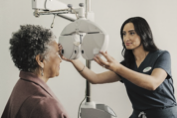Teachers have high visual demands every day due to the nature of their work. As a teacher, you may be prone to various forms of eye strain, experiencing a wide range of symptoms, including blurred vision, trouble focusing, eye twitching, headaches, or eyes that feel dry, watery, or tired.
These kinds of symptoms can be incredibly disruptive but can be addressed. Routine eye exams are the key to identifying the cause of eye strain and protecting vision. This is why the Canadian Association of Optometrists recommends that adults have their eyes tested every two years, every year for specific eye conditions, or as advised by their eye care professional.

An optometrist carries out visual health checks with a patient.
The root cause of eye strain can be particularly difficult to pinpoint for people in occupations such as teaching. Unlike office workers, teachers spend a lot of time switching between distance and near-focused tasks. This can cause eye strain, particularly if glasses are outdated or worn down on the nose. Optometrists often note that teachers tend to wear reading glasses on the end of their noses so they can look over them to see in the distance—but this can cause eye or neck strain and can even stretch out their glasses. Teachers may be spending extended periods of time on laptops or tablets, often without a proper ergonomic setup. If glasses aren’t prescribed properly for the digital setup, this can cause additional problems.
If you are experiencing eye strain or eye fatigue symptoms, it’s important to see an optometrist for an eye exam to determine what could be causing them and how they can best be treated. Optometrists can advise on all aspects of vision, ensuring that new prescriptions are right for your needs and considering all the different factors that might affect your comfort and clarity.
 The vision assessments performed by optometrists take into account focusing distances, lighting at work and home, device use, and patient preferences. If you already wear glasses, it may be that you need an updated prescription. There are many different lens options that enable clear vision at several different distances without the need to take glasses on and off. There are also options available to reduce glare and reflections from the surface of glasses.
The vision assessments performed by optometrists take into account focusing distances, lighting at work and home, device use, and patient preferences. If you already wear glasses, it may be that you need an updated prescription. There are many different lens options that enable clear vision at several different distances without the need to take glasses on and off. There are also options available to reduce glare and reflections from the surface of glasses.
Your optometrist may also advise on how to improve eye comfort, which could include taking regular screen breaks, adjusting the lighting in your workspace, using eye drops, or even making changes to your diet.
Many health benefit plans cover the cost of eye exams, with no or low out-of-pocket expense. We suggest visiting an optometry clinic that offers an OCT scan, which creates a detailed 3D image of your eye that helps your optometrist detect the early signs of certain eye conditions, like glaucoma. All the more reason to get an eye exam
checked off your to-do list!
References
opto.ca/eye-health-library/eye-exam
ABOUT THE AUTHOR
Naomi Barber
Naomi Barber is the Clinical Services Director at Specsavers Canada. Since qualifying as an optometrist in Australia in 2011, Naomi has championed the philosophy that quality eyecare should be both accessible and convenient. Naomi has been an advocate for embracing technology that empowers optometrists to deliver patient-centric care. Her leadership focuses on fortifying support for eyecare professionals, ensuring they can deliver exceptional care and make a meaningful impact on eye health throughout Canada.
This article is featured in Canadian Teacher Magazine’s Spring 2024 issue.











